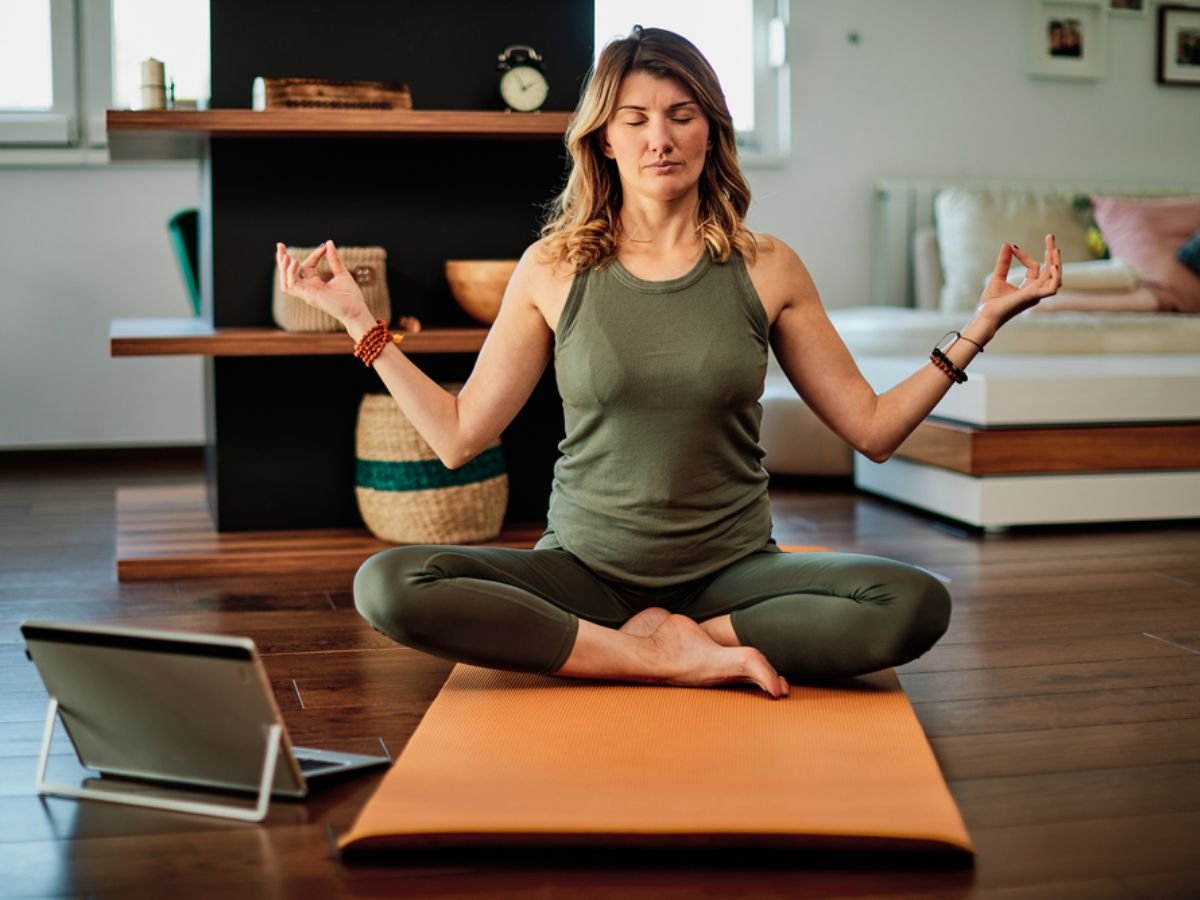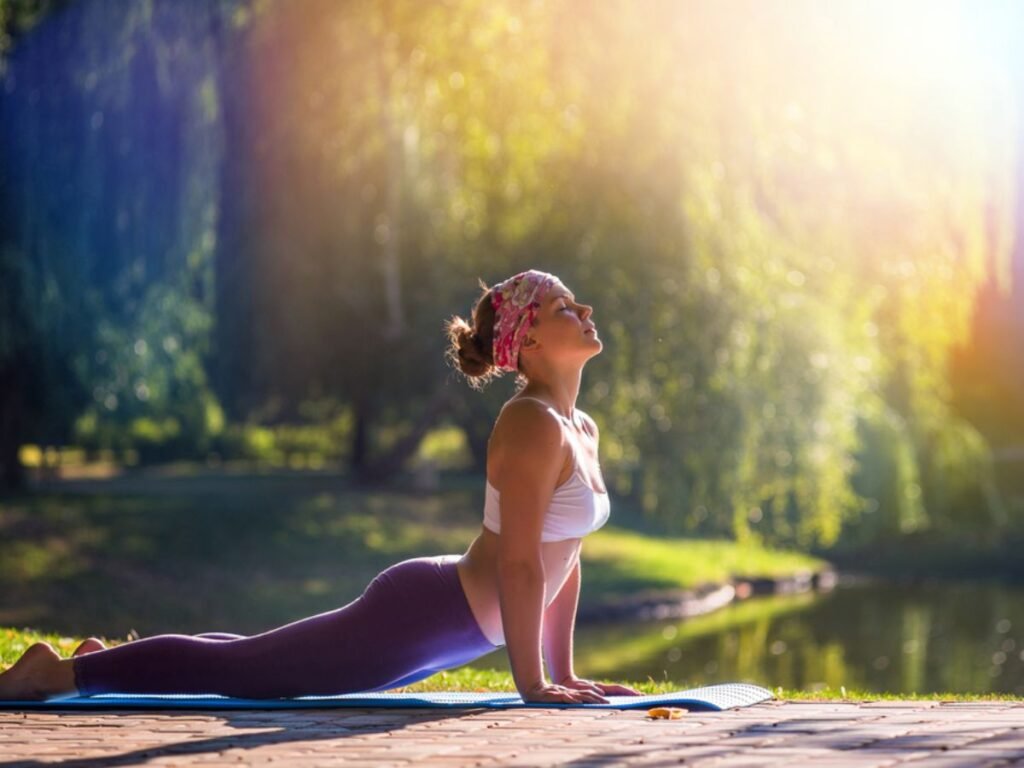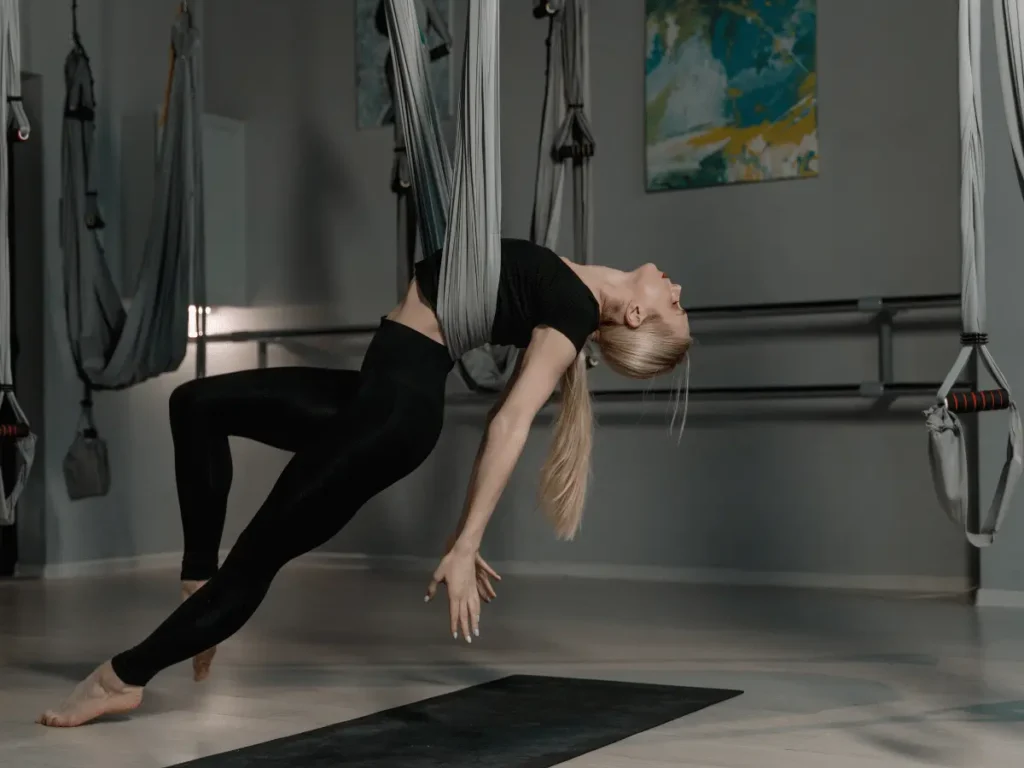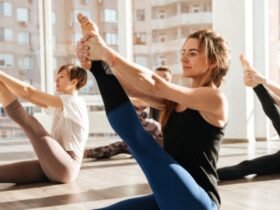Sweat Yoga is a form of yoga practiced in a heated environment designed to intensify the workout. The goal of Sweat Yoga is to promote physical exertion, flexibility, detoxification, and mental focus. It is typically practiced in a room where the temperature is significantly higher than normal room temperature, often ranging between 85°F to 105°F (29°C to 40°C). The heat encourages sweating, which is believed to help flush toxins from the body, increase circulation, and promote flexibility.
During a Sweat Yoga class people progress through various yoga postures as they experience heated conditions throughout the practice. Participants experience an authentic yoga experience because they gain heat benefits from its practice while practicing traditional poses like Bikram Yoga but without strict pose sequence rules.
This form of yoga is often seen as a fusion of fitness and mindfulness, targeting both the body and mind. If you’re wondering about what happens when you try Sweat Yoga for the first time, it can be an intense yet rewarding experience. What Happens When You Try Sweat Yoga? explores this further.
Benefits of Sweat Yoga for the Mind and Body
Sweat Yoga has numerous benefits for both physical and mental health:
Physical Benefits
Sweating in a heated room during Sweat Yoga plays a key role in detoxifying the body, as it helps flush out toxins through the skin. This process not only promotes better skin health but also supports the body’s natural detoxification processes. Sweating in yoga isn’t just for cooling down; it is essential for cleansing the body, which aligns with the detox benefits discussed in How Hot Yoga Changes Your Body.
Additionally, the heat warms up the muscles, making them more pliable and allowing for deeper stretches, thus increasing overall flexibility over time. If you’re looking to enhance your practice, selecting the right mat can make a big difference, and you can find more tips on this in Best Yoga Mats That Could Transform Your Practice. The combination of heat and intense movement also increases the heart rate, boosting calorie expenditure, which can aid in weight loss and improve cardiovascular health.
Moreover, the heat enhances blood circulation, speeding up muscle recovery and improving the delivery of oxygen to muscles and organs. As the class progresses, you’ll notice improvements in strength and muscle tone, as many of the sequences challenge both endurance and strength, helping to build a more toned physique.
Mental Benefits
Sweat Yoga, like traditional yoga, emphasizes mindfulness and meditation through breathwork, making it an effective practice for relieving stress and reducing anxiety. One of the core benefits of yoga is its ability to regulate the body’s stress response, and Sweat Yoga is no exception. For a deeper understanding of how meditation aids in calming the body’s stress response, you can explore How Meditation Changes Your Body’s Stress Response, which highlights the calming effects that complement the practice of Sweat Yoga.
Additionally, the challenging nature of Sweat Yoga, particularly in a heated room, requires intense concentration, which can significantly enhance mental clarity and improve focus. The meditative elements of Sweat Yoga also help practitioners achieve emotional balance, allowing them to experience a sense of calm and emotional well-being after each session.
Furthermore, the heat within Sweat Yoga helps people develop a solid bond between their bodies and minds so they better sense their physical self. The heightened bodily awareness leads to better physical results in addition to benefiting mental health completely.
Difference Between Sweat Yoga & Traditional Yoga
While both Sweat Yoga and traditional yoga share the same core foundation of physical postures, breath control, and meditation, there are a few key differences between the two:
| Sweat Yoga | Traditional Yoga |
| Temperature | |
| It is practiced in a heated room, usually between 85°F to 105°F (29°C to 40°C). The heat creates a more intense environment that helps increase the body’s flexibility and promotes sweating. | Typically practiced in a room at regular ambient temperatures, traditional yoga focuses on the postures, breathwork, and meditation without the addition of external heat. |
| Intensity | |
| The heat adds an element of intensity to the practice. This can result in faster calorie burning, a quicker pace of movement, and deeper stretches due to the warmth of the muscles. Sweat Yoga is more intense and fast-paced compared to traditional yoga styles like Hatha or Restorative Yoga. | While still a challenging workout, traditional yoga generally follows a slower pace, with a focus on breath control and alignment rather than heat-induced intensity. |
| Detoxification | |
| Sweating plays a crucial role in Sweat Yoga as the heat encourages the body to release toxins. The primary focus is on physical detoxification through the sweating process, alongside the mental benefits. | Detoxification through sweating isn’t as emphasized in traditional yoga. While some yoga styles (like Bikram Yoga or Hot Yoga) incorporate heat, many forms of traditional yoga don’t focus specifically on the process of sweating as part of their practice. |
| Class Structure | |
| Sweat Yoga classes often feature faster-paced sequences that encourage physical exertion and can include elements like Vinyasa or Power Yoga to maintain an elevated heart rate. | Traditional yoga offers a variety of class types, including slow-paced Hatha Yoga, gentle Restorative Yoga, and the more vigorous Ashtanga Yoga. These classes may not involve a heated room or a focus on intense physical exertion. |
History of Sweat Yoga
Sweat Yoga’s evolution is closely tied to the rise of heated yoga practices in the West, particularly through Bikram Yoga.
Origins of Hot Yoga
Hot Yoga, including Sweat Yoga, traces its origins to Bikram Yoga, which was founded by Bikram Choudhury in the 1970s. Bikram Yoga is a system of 26 yoga postures and two breathing exercises performed in a room heated to approximately 105°F (40°C). This practice gained popularity quickly due to its intense workout and detoxifying effects.
Adaptations and Growth
Multiple instructors started exploring alternative heated yoga variations as the popularity of hot yoga grew increasingly popular. The sequence of traditional poses was adapted by some instructors who also merged new yoga styles like Vinyasa Flow or Power Yoga with heated sessions. The adaptations produced Sweat Yoga as a new flexible accessible form of hot yoga which maintained the physical and mental advantages originally found in heated room practice.
Global Expansion
The rise of Sweat Yoga parallelled the wellness trend throughout the early 21st century because fitness practitioners found it useful to stretch their bodies while controlling weight and improving concentration. The growing popularity of heated yoga spaces referred to as Sweat Yoga studios affected major cities worldwide as increasing numbers of people desired to practice yoga in hot conditions. Multiple studios provide different versions of Sweat Yoga which meet diverse fitness needs through unique workout formats thus enabling people both new to yoga and those with experience to participate.
Current Trends
Sweat Yoga continues to evolve, with new styles and variations emerging. Many studios offer unique takes on the practice, incorporating elements of other fitness regimens such as Pilates, strength training, and mindfulness meditation. Additionally, online platforms and virtual classes have made Sweat Yoga more accessible, allowing practitioners to join classes from the comfort of their homes. Some studios even offer specialized practices, such as Yoga Poses for Strength to build your physical endurance.
Safety Considerations in Sweat Yoga
Practicing Yoga in a heated room requires special attention to safety due to the intense physical exertion and increased body temperature. It’s important to stay well-hydrated before, during, and after class to avoid dehydration, which can cause dizziness or fainting. Practitioners should listen to their bodies and rest when needed, especially if they feel lightheaded or overheated.
If you’re new to Sweat Yoga, it’s advisable to ease into it gradually by starting with shorter sessions. Those with cardiovascular issues, heat sensitivity, or respiratory conditions should consult a doctor before attempting Sweat Yoga, as the heat can exacerbate certain conditions. It’s always important to know your limits and be mindful of overexertion.
If You are Trying For First Time Use These Tips
If you’re attending your first Sweat Yoga class, it’s important to come prepared. Start by wearing lightweight, moisture-wicking clothing to keep you comfortable during the session. Bring a large towel, as the heat will make you sweat more than usual, and a water bottle to stay hydrated throughout the class. Arrive early to give yourself time to acclimate to the heat and settle in.
If at any point during the session you feel dizzy or overheated, don’t hesitate to take a break. It’s also helpful to inform your instructor if you’re new so they can provide guidance or modifications for certain poses. Gradually increasing your practice will help you build tolerance to the heat and intensity over time.
Comparisons with Other Hot Yoga Styles
Sweat Yoga, Bikram Yoga, and Hot Yoga are often grouped together, but they differ in certain aspects. Bikram Yoga follows a fixed sequence of 26 postures and two breathing exercises in a room heated to 105°F (40°C). Sweat Yoga, on the other hand, offers more flexibility in the poses and sequences, allowing for a more dynamic and varied practice.
Hot Yoga is a general term for any yoga practiced in a heated environment, typically around 95°F (35°C) to 100°F (37°C), and may include various styles like Vinyasa or Power Yoga. While all these styles aim to increase flexibility and promote sweating, Sweat Yoga stands out for its adaptability and inclusion of various yoga types.
Post-Class Care
After a session, it’s crucial to prioritize recovery to maintain your body’s balance. First and foremost, hydrate with water or an electrolyte drink to replace fluids lost during sweating. Stretching gently after class can help prevent muscle tightness and improve flexibility. Eating a light, balanced meal or snack with a good mix of carbohydrates and protein will replenish your energy and help with muscle recovery.
Avoid intense physical activities for a few hours after your class, as your body needs time to cool down and reset. If you experience any soreness, consider using a foam roller or getting a relaxing massage to alleviate tight muscles.
Sweat Yoga for Specific Health Conditions
Sweat Yoga can offer benefits to those with specific health conditions, but it’s important to approach the practice with caution. For individuals with chronic conditions such as arthritis, the heat can aid in improving joint flexibility and reducing pain.
However, anyone with heart conditions, high blood pressure, or respiratory issues should consult a doctor before participating, as the heat and intensity may put extra strain on the body. Pregnant women should avoid high-intensity yoga styles like Sweaty Yoga and should consult their healthcare provider for advice on safer alternatives.
For those with mental health conditions like anxiety or depression, the mindfulness and stress-relieving benefits of Sweat Yoga can be particularly helpful in improving emotional well-being.
Sweat Yoga and Diet
Nutrition plays an essential role in complementing the benefits of Sweat Yoga. It’s crucial to stay hydrated before, during, and after class, as the heat causes significant fluid loss. Water is important, but adding an electrolyte drink can help replace essential minerals lost through sweat.
Before class, it’s best to eat a light meal that includes carbohydrates for energy and some protein for muscle support. After class, consuming a balanced meal with proteins, healthy fats, and carbohydrates will help replenish your body and support muscle recovery. Avoid heavy meals right before class, as they can cause discomfort when performing poses.
Sweat Yoga is a dynamic and challenging practice that merges traditional yoga with the intensity of heat. It promotes both physical fitness and mental clarity, providing a comprehensive wellness experience. Whether you’re looking to build strength, improve flexibility, or focus on detoxifying your body, Sweat Yoga offers a holistic approach to health. If you’re curious about other types of yoga that focus on relaxation or body rejuvenation, you might also explore the world of face yoga with 5 Face Yoga Moves for a Perfect Jawline.






















Leave a Reply
View Comments